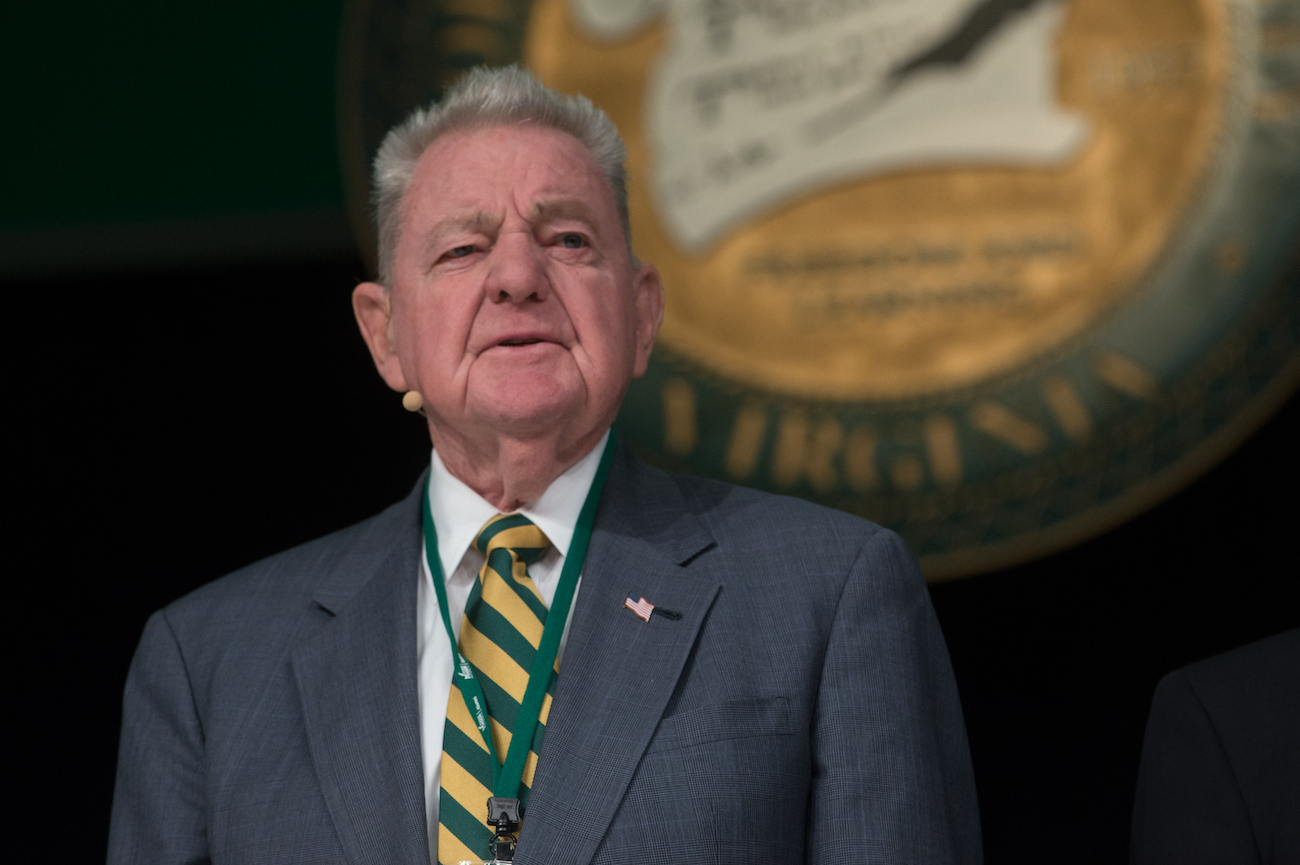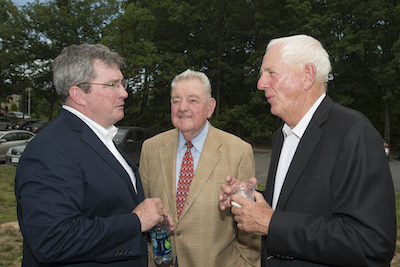
John Tilghman “Til” Hazel Jr., the visionary real estate lawyer and developer who recognized the impact George Mason University could have as the anchor of a region he principally transformed from pasture to prominence, died March 15. He was 91.
Hazel cleared the way for the university’s emergence by working with George Mason College officials to secure 421 acres—more than 30 parcels of land—for the Fairfax Campus. He was also the driving force behind Mason acquiring a law school in the 1970s, one of the first moves that announced Mason as an institution with grand ambitions following its separation from the University of Virginia in 1972.
In service to the university almost since its inception in 1957, Hazel was an advisory board member, established and later chaired the George Mason University Foundation, and was appointed by Gov. A. Linwood Holton to the inaugural Board of Visitors. He also served two stints as rector, and for decades was a chief philanthropist, patron, cheerleader and champion of the university from the boardrooms of Northern Virginia to the chambers of the General Assembly in Richmond.

In 1987, the university awarded him the first Mason Medal, the institution’s highest honor.
“Til Hazel was a founding father of the world-class George Mason University we know today,” Mason President Gregory Washington said. “It is impossible to overstate his influence on the ascent of this region and the profound effect his advocacy and service had on this young university. Til was a Patriot through and through.”
A buzzcut-sporting, straight-shooter Harvard graduate, equal parts folksy and firm, Hazel flaunted his Mason affiliation long before it was fashionable, sporting a “GMU” vanity plate on his Oldsmobile, the Washington Post reported almost three decades ago.
But Hazel’s most influential work on behalf of the university took place behind the scenes. He mobilized the Northern Virginia business community to support and work with the university, creating a symbiotic relationship between Mason and the region’s business interests that exists to this day.
Hazel, who early in his legal career worked to acquire land for what became the Capital Beltway, tapped into his vast resourcefulness for land acquisition, zoning law know-how and business horse sense to twist arms and win minds in Richmond to steer the growth and direction of a fledgling university. State lawmakers and education officials at first resisted the rise of Mason, which now has grown into the largest and most diverse university in the state.

“We were suddenly an independent institution trying to figure out where we were going,” Hazel said in an interview in 2011 with the University Libraries’ Special Collections Research Center. “And that took a while to emerge, but it was pretty well obvious that we needed to create an institution of quality and commitment and broad-based to handle what we saw as the vision of Northern Virginia.”
Not everyone shared his vision. Hazel engaged in a years-long tussle in Richmond lobbying for the university to be permitted to create a law school. He believed that a law school would offer Mason instant credibility, at an affordable price, and serve the overflow of applicants at existing law schools in the Washington, D.C., area.
Continually rebuffed, Hazel ultimately brokered a deal between the university and the financially strapped International School of Law in Arlington—with Hazel co-signing the $3 million note that also netted real estate near the Metro in Arlington, laying the foundation in 1979 for what would become Mason’s Arlington Campus.
Since 2005, the law school—now the Antonin Scalia Law School—has resided in John T. Hazel Jr. Hall, named after the Arlington native and former Fairfax County general district court judge.
Hazel said in the oral history that it was important to him that everyone in Northern Virginia realize Mason was no longer a two-year school supporting the University of Virginia but a full-fledged university. He believed adding a professional school would help do that.
The momentum from the law school acquisition led to state approval for Mason to award doctoral degrees, another crucial step toward the university’s prominence.
Named by the Times-Community newspaper around the turn of the millennium one of three Fairfax County “Citizens of the Century,” Hazel not only supported Mason, he supported colleges and universities around the state. Calling education “the foundation of all that I ever did,” Hazel in the mid-90s founded the Virginia Business Higher Education Council to bring together the state’s business leaders and university presidents to oppose state budget cuts to higher education.
In the 2009 book “The Fight for Fairfax: A Struggle for a Great American County,” former Mason president Alan Merten said that the money Hazel gave to Mason “wasn’t nearly as massive as his influence or his willingness to lead and fight.”
“My father was so proud of George Mason University from its modest beginnings to the status it enjoys today serving nearly 40,000 students,” said Mason rector Jimmy Hazel, Til Hazel’s son and Mason law school alum. “He had a grand vision for this university, but I think in 50 short years we’ve exceeded even what he thought possible.”
While many of his contemporaries favored slow growth, Hazel’s ambitions yielded, as he joked at a lecture at Mason’s Center for Real Estate Entrepreneurship in 2014, a strategy some considered “growth management through litigation.”
The result was not just more subdivisions and shopping centers but a regional identity with a major university at its core. Joel Garreau, a former senior fellow in what is now Mason’s Schar School of Policy and Government, declared in his 1991 book, “Edge City: Life on the New Frontier” that Hazel did “more to shape the Washington area than any man since Pierre L’Enfant.”
"His imagination is what drove development,” former Mason president George Johnson, a close friend of Hazel’s, told Washingtonian magazine in 2001. “Not just land development but the cultural development of the region as well."
